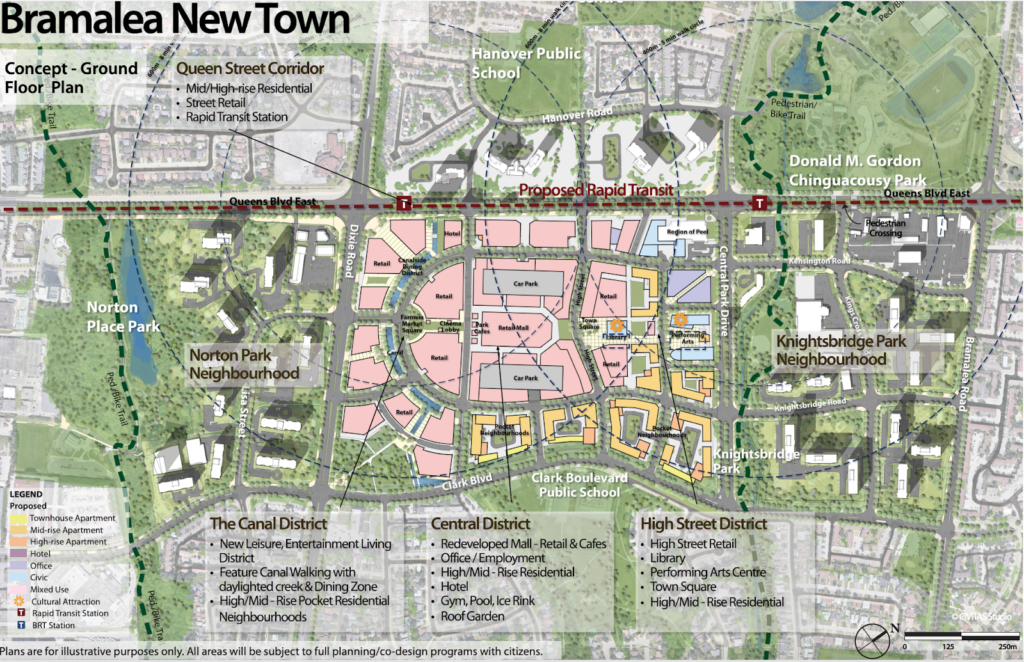The planned bus rapid transit (BRT) corridor along Highway 7 in Vaughan and Queen Street in Brampton will be a transformative infrastructure for both these communities and the Greater Toronto Area as a whole. While improved transit coverage and service will benefit residents and businesses in southern Vaughan, it is the City of Brampton that stands to gain the most from the implementation of this project. Most notably, the project will offer more opportunities for investment in the areas along its route, be instrumental in increasing tax and local revenues, and improve upon what is already a robust local transit network in the city. For both of these beneficial outcomes, the technology and expertise offered by Render Developments is poised to play a central role in their achievement.
Queen BRT: Project Overview
At present, the Queen Street corridor is served by local bus routes and the 501 Züm Queen rapid bus service. The 501 sees some of the highest service frequencies in the Brampton Transit network, and (by virtue of running along Highway 7 to Vaughan Metropolitan Centre (VMC) and along Highway 407 to York University) serves as a major route for regional connectivity. Within the City of Vaughan, it is also interlined/fare integrated with York Region Transit’s Viva Orange bus rapid transit route, with the two routes providing a higher service frequency along Highway 7 from VMC to Martin Grove Road.
The Queen BRT would essentially be an enhancement of this service. While running more buses is highly beneficial for riders, the core component of bus rapid transit is the creation of infrastructure that allows for faster and more reliable service than having buses operate in mixed traffic. The Viva Rapidways that have been built along Yonge Street, Highway 7 and other major York Region thoroughfares provide a template for what such a system could look like. Dedicated bus-only lanes would be built along Queen Street, with stations featuring platforms and completely enclosed designs – a far cry from the region’s typical bus stops. By making such improvements, riders will be able to enjoy faster and more reliable bus services, as well as a more comfortable passenger experience while waiting for buses. Most importantly, a fully built-out Queen BRT would serve as a frequent transit spine for a major swathe of the Greater Toronto Area. In this role, it would make travel between distant regional destinations much easier. At the same time, also providing Brampton with a higher-order transit corridor operating east-west through the city – a role that is planned to be complimented by the Hurontario LRT, with which it will intersect in the city’s downtown. Current technological advances are well-adapted to create comprehensive plans of transportation systems and modes that are available (or planned for) communities. At the same time, they have been used to the benefit of municipalities throughout Ontario. The combination of these two factors are integral to the success of projects such as the Queen BRT, as they can be applied to attract business investment (thereby increasing city revenue) and to aid in network planning for transit agencies – both of which will be key to making Brampton’s vision for the Queen Street corridor a success.

Image 1: Current map of the Queen BRT study area. Map courtesy of Metrolinx
Development Potential and Brampton’s Future Vision
As outlined in the city’s 2040 Vision, Brampton envisions two large-scale redevelopment projects occurring along the route of the Queen BRT, with these being located in the city’s downtown and on the site of Bramalea City Centre shopping plaza. In regards to the former, the new BRT corridor will play a major role in making Downtown Brampton a major local and regional transit hub. With frequent Züm service (and eventually the Hurontario LRT) on Main Street, GO rail service on the Kitchener line and a host of local bus routes – thereby fulfilling a key component of the 2040 Vision, which calls for a more transit-focused living experience. As a result, future plans call for the number of residents in Downtown Brampton to increase from 7,000 to 55,000 by 2040. If we take the median income for Brampton, that’s $5,328,000,000 in yearly added income for the area. This is set to be achieved through the construction of a multitude of new residential projects, as well as the transformation of the area into a predominately mixed-use district – a district whose success will be predicated on transit infrastructure such as the Queen BRT.
While revitalization in Downtown Brampton is a core component of the city’s future plans, the most transformative changes are set to occur as part of what the 2040 Vision refers to as Bramalea New Town. Situated at the intersection of Queen Street and Dixie Road, the New Town community will be centered on a redeveloped Bramalea City Centre Plaza, with the areas surrounding the mall becoming a residential and employment nexus for Bramalea. Current plans for the area show stations on the Queen BRT being located at Dixie and at Central Park Drive, which will put much of the area within walking distance of higher-order transit. It is arguably the Queen BRT which is most important to ensuring that the Bramalea New Town project is a success. Downtown Brampton already has a rail connection, is poised to gain another and is also served by numerous local and regional bus routes, and while the Queen BRT will be an important connection the downtown core is already well-served by higher-order transit. By contrast, Bramalea City Centre (specifically the adjacent Bramalea Terminal) is a hub for local routes but has few regional connections besides an hourly GO bus service. As a result, the Queen BRT’s presence will provide the area with a major connectivity boost, which will in turn make Bramalea New Town a more desirable location for future investment opportunities. The increased development and population in the area also allows for it to produce more revenue for Brampton as a whole (whether through higher tax revenue or better transit farebox recovery as a result of improved service). Brampton’s plans for Bramalea New Town’s future (a future made brighter by the Queen BRT) present the perfect opportunity for it to take advantage of the latest advances in proptech in order to help attract business investment. In particular, the creation of “virtual tours” will be especially useful in regards to mapping out the layout of future redevelopment plans. Through the use of stunning drone photography and 360-degree views of areas primed for investment, the city would be able to showcase the immense investment potential that the Queen BRT will unlock in neighborhoods along its route.

Image 2: An aerial map of the plans for Bramalea New Town showing how the Queen BRT will interact with the future development. Map courtesy of the City of Brampton.
A Corridor Poised for Greatness
The Queen Street corridor presents a multitude of unique investment opportunities along its route, and the Queen BRT will be what links these prime locations together. At the same time, the frequent and reliable services that it provides will make future residential and commercial development along its route more viable. While the potential of this new transit route is best exemplified by the Bramalea New Town community, any of its new stations would be primed to serve as anchors for residential intensification or mixed-use redevelopment. Additionally, the combination of better service and higher rates of investment will be highly beneficial for the city’s economy, in large part due to the increased revenue that such changes would provide. No matter the type of project or the location, access to the most cutting-edge proptech and expertise will be integral to making the Queen Street BRT an economic catalyst for the city of Brampton.
List of Sources:
https://www.metrolinx.com/en/projects-and-programs/queen-st-hwy-7-brt
https://www.brampton.ca/EN/City-Hall/Brampton-2040-Vision/Pages/Welcome.aspx
